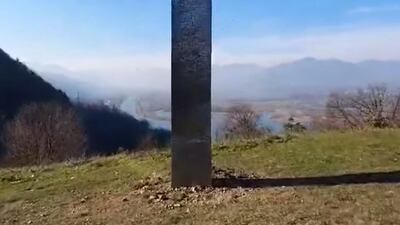Is it art or is it aliens? After the discovery of yet another monolith, this time on a hill in Romania, many people may be leaning towards the latter when it comes to the case of the mysterious silver pillar.
Just as the object, found in the Utah desert about two weeks ago, vanished without explanation, a similar structure has appeared in the city of Piatra Neamt.
The four-metre-tall monolith has been spotted on Batca Doamnei Hill, according to local media, located close to the historic Petrodava Dacian Fortress.
According to photographs shared on social media, the pillar is crafted from a shiny silver-like metal. Though it bears a resemblance to the Utah monolith, it doesn't appear to be the same structure, with the Romanian version displaying etchings on its exterior. Plus, this one is triangular in shape.
No one has yet taken credit for its sudden appearance, though officials have launched an investigation.
"We have started looking into the strange appearance of the monolith," Rocsana Josanu of the Neamt Culture and Heritage Department told the Daily Mail.
“It is on private property, but we still don’t know who the monolith’s owner is yet. It is in a protected area on an archaeological site. Before installing something there, they needed permission from our institution, one that must then be approved by the Ministry of Culture.”
The discovery is all the more intriguing as it follows close on the heels of the disappearance of the silver monolith in the Utah desert, which baffled local authorities. The pillar was removed by “an unknown party” some time on Friday, November 27, according to the state’s Bureau of Land Management (BLM).
The agency added that while the structure was “illegally installed” on public land, it is seen as private property by authorities. “The BLM did not remove the structure, which is considered private property. We do not investigate crimes involving private property, which are handled by the local sheriff’s office,” a statement said.






Biologists discovered the Utah monolith from a helicopter during an annual survey of wildlife in the area on November 18. "I'm assuming it's some new wave artist, or somebody who is just a big 2001: A Space Odyssey fan," helicopter pilot Bret Hutchings told Utah news station KSL 5 TV.
The Utah Department of Public Safety (DPS) released photos and video of the structure to the public, but did not disclose its location. Online sleuths were quick to track down the monolith, however, comparing the publicised photos, old satellite images and online maps to pinpoint its location.
So far, no artists have claimed ownership of the work either in Utah or Romania.


